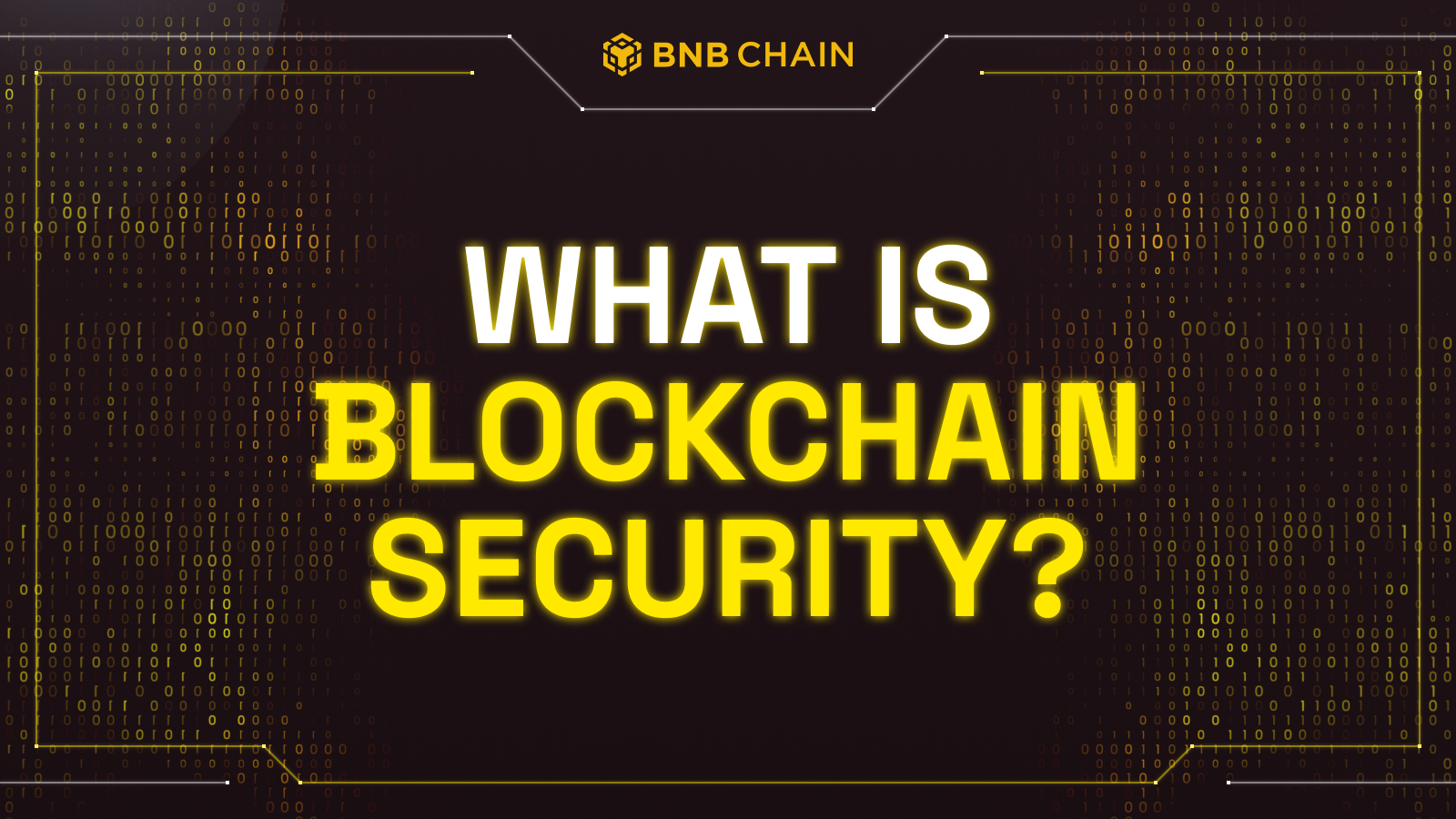Table of Contents

With the growing sophistication of cyber threats, staying ahead of the curve is imperative when it comes to blockchain security. Proactive measures have led to a 65% decline in year-over-year illicit transaction volume halfway through 2023. However, as the blockchain ecosystem evolves, so do tactics used by hackers and cybercriminals. This is why organizations require a robust security framework.
This article will discuss blockchain security, how it differs between different blockchain types, and how blockchains are secured. We will also briefly examine BNB Chain and its initiatives to ensure blockchain security.
What Is Blockchain Security?
Simply put, blockchain security is the combination of cybersecurity tools, principles, and best practices to mitigate any type of risk, such as malicious attacks and unauthorized access to blockchain networks. The data structures produced by blockchain technology come with inherent security qualities based on the principles of cryptography, consensus, and decentralization. Most blockchains or distributed ledger technologies structure data into blocks, each containing a transaction or a bunch of transactions.
New blocks are connected to previous blocks in a cryptographic chain, making them impossible to tamper with. Transactions within these blocks are validated and agreed upon using a consensus mechanism, ensuring all transactions are correct. Blockchain technology enables decentralization through the participation of users based on a distributed network, removing the risk of a single point of failure. Transactions, once recorded on the blockchain, cannot be changed. However, some key differences exist regarding the security aspects of different blockchains.
As mentioned earlier, all blockchains are based on distributed ledger technology. However, not all blockchains are equally secure. Security models on public and private blockchains are very different due to the nature of their networks (open/closed).
Security On Public Blockchains
Public blockchains are open and permissionless networks that anyone can interact with. The codebase of such blockchains is publicly available and is continually checked by a community of developers. These developers review the code and check for bugs, vulnerabilities, and other risks. While developers continuously examine the code to improve it, hackers and other malicious players also examine the code for potential vulnerabilities to exploit.
All network participants are responsible for securing a public blockchain. These participants include validators and node operators tasked with maintaining the network and developers working on the code. Users on the blockchain also play a crucial role in ensuring overall security by practicing basic security hygiene. Thanks to such a high level of decentralization, public blockchains are incredibly resilient against an array of attacks.
Public blockchains also have dedicated organizations devoted to furthering their advancement, development, adoption, and driving community engagement. One of the most prominent examples of such an organization is the Ethereum Foundation. Even Bitcoin has a dedicated team that monitors, updates, and improves the Bitcoin Core software. Any changes to either Ethereum or Bitcoin are put forward as proposals that must be accepted by consensus. Anyone can propose an EIP (Ethereum Improvement Proposal) or a Bitcoin Improvement Proposal (BIP).
Security On Private Blockchains
Private blockchains are exclusive networks that grant only limited access. These blockchains typically use identity to confirm access privileges and permit only known organizations to access them. Private blockchains in permissioned networks achieve consensus through selective endorsement. Where only known users can verify transactions, and only those with special privileges can maintain the transaction ledger. The security of a private blockchain is the sole responsibility of its operating entity. Since these blockchains are more centralized, there is a single point of failure. This is why the controlling entity or institute must implement robust security measures.
The reduced computational work for consensus algorithms makes private blockchains significantly faster and more efficient than public blockchains. However, the control of a private blockchain by a single entity or group of entities introduces the risk of shutdown or manipulation. Public blockchains are generally free of such risks.
How Are Blockchains Secured?
A blockchain network consists of a global network of computers, called nodes, that execute, verify, and record transactions. Each node maintains a copy of the ledger, ensuring no centralized authority or single point of failure exists. When a block is added to the chain, it is verified. This is where consensus mechanisms come into the picture. There are several consensus mechanisms, with Proof-of-Work and Proof-of-Stake being the most popular.
In a Proof-of-Work system, miners compete to solve complex problems and validate transactions. On the other hand, Proof-of-Stake requires participants to stake a specific amount of tokens to run a node and validate transactions. Upon completion, a block is closed and linked to the preceding block through a cryptographic code. Cryptography links each block, and the distribution of the ledger across numerous nodes (computers) ensures that any attempt to alter or manipulate a block is quickly identified.
Why Do Blockchains Require Security?
A blockchain is inherently secure because it uses cryptography to secure data and eliminates the need for third-party organizations. However, there are some loopholes that hackers can exploit to compromise the blockchain. Some well-known attack types are as follows:
- 51% Attack – A 51% attack is an attack on a blockchain by a miner or a group of miners controlling more than 50% of the network’s mining hashrate. A successful attack allows the attacking miners to alter the blockchain, prevent new transactions, and halt payments between users. Bitcoin Cash and Ethereum Classic have experienced 51% attacks in the recent past.
- Sybil Attacks – A Sybil attack is a type of attack in which a single node operates multiple identities simultaneously to undermine authority in reputation-based systems. The primary goal of Sybil attacks is to gain influence in the network and execute illegal actions.
- Finney Attack – A Finney attack is a type of attack specific to blockchains using Proof-of-Work consensus mechanisms. It exploits time delays between a transaction’s broadcast and its inclusion in a block, leading to a profit for the attacker.
- Eclipse Attack – In an Eclipse attack, threat actors isolate a single node or user within a network. The attacker then redirects the target’s inbound and outbound connections to nodes controlled by the attacker. This seals off the target node in an environment isolated from network activity.
- Phishing Attacks – Phishing is a common tactic hackers use to gain access to a user’s credentials. Hackers actively send users emails and promotional messages that mimic those from legitimate senders. These communications generally ask for user credentials, using fake links to redirect users to malicious websites. Once the unsuspecting user enters their credentials, the hackers gain access to all their sensitive information, resulting in significant losses for the user and blockchain network.
BNB Chain Blockchain Security Initiatives
BNB Chain has taken several initiatives to ensure blockchain security such as the launch of AvengerDAO and DappBay’s Red Alarm.
AvengerDAO is a community-run project to protect BNB Chain users from exploits, scams, and malicious threat actors. It consists of a passive API system, Meter, a subscription-based alert system called Watch, and a programmable fund management system called Vault. It is the result of a collaboration between leading Web3 security firms including Certik, SlowMist, BlockSec, Go Plus, Zokyo, BlockSec, Verichains, Hashdit, Pessimistic, TrustWallet, PancakeSwap, CoinMarketCap, BSCtrace(NodeReal), BSCscan, MathWallet, DappBay, Coin98, and Opera.
BNB Chain’s DappBay assists users in discovering new Web3 projects. DappBay comes with a novel feature called Red Alarm.
Red Alarm assesses risk levels associated with a project in real-time, alerting users of risky decentralized applications. The Red Alarm feature allows users to check if a contract has flaws or fraud risks. DappBay’s ultimate goal is to facilitate community understanding of market trends and anticipate project dangers in real-time.
As a result of all these security measures (and more), BNB Chain saw a staggering 85% decline in security incidents in 2023 as compared to 2022.
Plus, BNB Chain also has a bug bounty program, offering bounty hunters upto $100,000 in rewards. This further underscores its commitment to security.
Conclusion
As blockchain networks continue to evolve, so will blockchain security. In the near future, we may see enhanced cybersecurity frameworks tailored for specific blockchain applications. Communities, organizations, and even governments could come together for a collaborative effort to establish global cybersecurity standards. Ultimately, we could also see the creation of even more robust and resilient blockchain security systems through collective wisdom, distributed ownership, and transparency.


